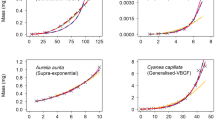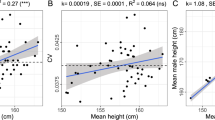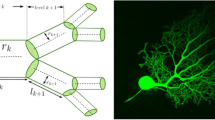Abstract
GROWTH gradients in animals have been represented by a method described by Huxley1, based on growth constants, that is, the values of α in the allometry formula2, y = bxa. Huxley1 has discussed the inadequacy of his graphical method and the formal difficulties of devising a better, but no attempt seems to have been made to overcome these difficulties. It is thought that the simple mathematical considerations below constitute a solution to the formal obstacles in the way of the quantitatively accurate representation of certain types of growth gradient. The gradients referred to here are gradients in heterauxesis3 in which the growth intensities are in the direction of the axis along which the gradient lies. Multiplicative growth in length only is discussed, but similar concepts apply to multiplicative growth in area, volume and weight.
This is a preview of subscription content, access via your institution
Access options
Subscribe to this journal
Receive 51 print issues and online access
$199.00 per year
only $3.90 per issue
Buy this article
- Purchase on Springer Link
- Instant access to full article PDF
Prices may be subject to local taxes which are calculated during checkout
Similar content being viewed by others
References
"Problems of Relative Growth" (London, 1932).
Huxley, J. S., and Teissier, G., Nature, 137, 780 (1936).
Huxley, J. S., Needham, J., and Lerner, I. M., Nature, 148, 225 (1941).
Arch. Entw. Mech., 129, 402 (1933).
Author information
Authors and Affiliations
Rights and permissions
About this article
Cite this article
HEWLETT, P. Graphical Representation of Growth Gradients. Nature 154, 611–612 (1944). https://doi.org/10.1038/154611a0
Issue Date:
DOI: https://doi.org/10.1038/154611a0
Comments
By submitting a comment you agree to abide by our Terms and Community Guidelines. If you find something abusive or that does not comply with our terms or guidelines please flag it as inappropriate.



